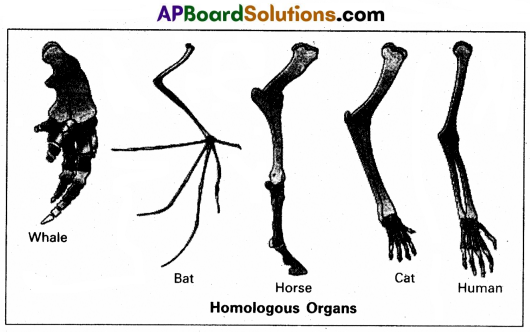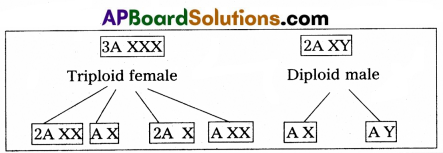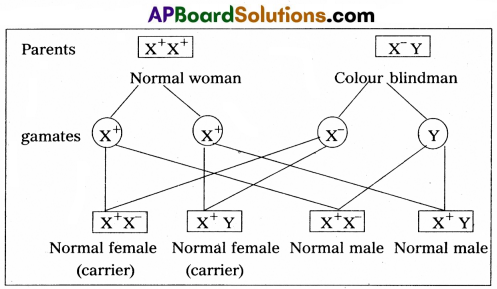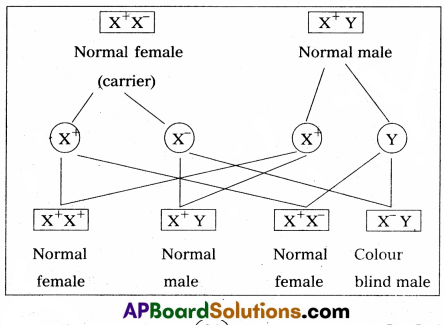Thoroughly analyzing AP Inter 2nd Year Zoology Model Papers Set 1 helps students identify their strengths and weaknesses.
AP Inter 2nd Year Zoology Model Paper Set 1 with Solutions
Time: 3 Hours
Maximum Marks: 60
Section – A (10 × 2 = 20)
Answer all the questions. (Very Short Answer Type)
Question 1.
Explain the terms thecodont and diphyodont dentitions.
Answer:
Thecodont: Teeth of human beings are embedded in the sockets of the jaw bones is called thecodont.
Diphyodont: Majority of mammals including human beings form two sets of teeth during their life time, a set of temporary / milk teeth replaced by a set of permanent teeth. This type of dentition is called diphyodont dentition.
Question 2.
Write the differences between open and closed systems of circulation.
Answer:
| Open circulation system | Closed circulation system |
| 1. In this type, blood flows from the heart into the arteries and then into large spaces called sinuses. | 1. In this type blood flows through series of blood vessels. |
| 2. Organs located in the space are bathed by blood. | 2. Each organ has blood vessels which carry blood to it. |
| 3. Blood flows slowly because there is no blood pressure after the blood leaves the blood vessels. | 3. Blood flows at a high-speed because there is high blood pressure after the blood leaves the heart. |
| 4. It is found in Leeches, arthro-pods and molluscs. | 4. It is found in annelids and chordates. |
![]()
Question 3.
What is a ‘motor unit’ with reference to muscle and nerve ?
Answer:
Motor unit is made up of a motor neuron and set of muscle fibres innervated by all the telodendrites.
Question 4.
What is insulin shock ?
Answer:
Hyper secretion of insulin leads to decreased level of glucose in blood (hypoglycemia) resulting in insulin shock.
Question 5.
Define gestation period. What is the duration of gestation period in the human beings ?
Answer:
The period during which embryo development takes place in uterus is called gestation period. In humans the gestation period is 266 days (38 weeks) from the fertilization of egg or 40 weeks from the start of last menstrual cycle.
Question 6.
Compare the importance of Y-chromosome in human being and Drosophila.
Answer:
In human beings Y-chromosomes are responsible for the development of maleness.
In Drosophila Y-chromosome, lacks male determing factors, but contains only genetic information essential to male fertility.
Question 7.
What is meant by genetic load. Give an example.
Answer:
The existence of deletorious genes within the populations is called genetic load.
Eg : Genes for Sickle cell anaemia – The individuals homozygous for Sickle cell gene usually die early due to anaemia.
Question 8.
Name the aortic arches arising from the ventricles of the heart of man.
Answer:
- Pulmonary arch – arises from right ventricle.
- Left systemic arch – arises from left ventricle.
Question 9.
Define atavism with an example.
Answer:
Sudden appearance of some vestigial organs in a better developed condition is called atavism. Eg : Tailed human baby.
Question 10.
Explain the term hypophysation.
Answer:
Making the fishes to breed artificially to meet the demand of carpseed as called hypophysation.
![]()
Section – B (6 × 4 = 24)
Answer any six questions. (Short Answer Type)
Question 11.
Describe the important steps in muscle contraction.
Answer:
During skeletal muscle contraction, the thin filament slides over the thick filament by repeated binding and releases myosin along the filament.
Important steps in muscle contraction :
Step 1 : Muscle contraction is initiated by signals that travel along the axon and reach the neuro muscular junction. As a result, acetyl choline is released into the synaptic cleft by generating an action potential in sarcolemma.
Step 2 : The generation of this action potential releases calcium ions from sarcoplasmic reticulum in the sarcoplasm.
Step 3 : The increased calcium ions in the sarcoplasm leads to the activation of actin sites, then active actin sites are exposed and this allows myosin heads to attach to this site and forms cross bridges by utilising energy from ATP hydrolysis.
Step 4 : The actin filaments are pulled. As a result, the ‘H’ zone reduces. It is at this stage that the contraction of the muscle occurs.
Step 5 : After muscle contraction, the myosin head pulls the actin filament and releases ADP along with phosphate. ATP molecules bind and detach myosin and the cross bridges are broken and decreases the calcium ions contraction. As a result masking the actin filaments and leading to muscle relaxation.
Question 12.
Describe the ventricles of the heart of man.
Answer:
Two ventricles right and left form the posterior part of the heart. These are the thick walled blood pumping chambers, separated by interventricular septum. The wall of the left ventricle is thicker than that of the right ventricle. The inner surface of ventricles is raised into muscular ridges or columns known as columnae carneae projecting from the inner walls of the ventricles. Some of them are large and conical and known as papillary muscles. Collagenous cords are known as chordae tendineae are present between atrio-ventricular valves and papillary muscles. They prevent the cusps of the antrio-ventricular valves from bulging too far into atria during ventricular systole.
Question 13.
Distinguish between homologous and analogous organs.
Answer:
1. Homologous organs : The organs which have similar structure and origin but not necessarily the same function are called homologous organs. Eg: The appendages of vertebrates such as the flippers of whale, wings of bat, forelimbs of horse, paw of cat and hands of man have a common pattern in the arrangement of bones even though their external form and functions may vary to suit their mode of life.

2. Analogous organs : The organs which have dissimilar structure and origin but perform the same function are called the analogous organs. Eg : Wings of butterfly and wings of a bird.

Question 14.
Give an account of the secretions of pituitary gland.
Answer:
The pituitary gland is also called hypophysis. Anatomically pituitary gland is divided into anterior and posterior pituitary.
I. Anterior Pituitary : It produces six important peptides. They are ;
- Growth hormone (GH) Somatotropin : They promote growth of the entire body by increasing protein synthesis, cell division and cell differentiation.
- Prolactin : It causes enlargement of the mammary glands of the breast and initiate the maintenance of lactation in mammals. Prolactin also promote the growth of corpus luteum and stimulate the production of progesterone.
- Thyroid stimulating hormone (TSH) : It stimulates the production of thyroid hormones from thyroid gland.
- Adreno corticotropic hormone (ACTH) : Controls the production of steroid hormones called gluco corticoids, by the adrenal cortex.
- Follicle stimulating hormone (FSH) : It stimulates growth the development of the ovarian follicles in females. In males FSH along with the androgens, regulates spermatogenesis.
- Luteinizing hormone (LH) : In males it stimulates production of androgens. In females it stimulates the ovaries to produce estrogens and progesterone and it maintains corpus luteum.
II. Posterior pituitary : It stores and releases two hormones called oxytocin and vasopressin.
Oxytocin : In females it stimulates contraction of pregnant uterus during child birth and ejection of milk from the mammary gland.
Vasopressin (ADH) : Affects the kidney and stimulates reabsorption of water and electrolytes by the DCT and collecting duct.
Question 15.
Describe microscopic structure of testis of man.
Answer:
The testes or testicles area pair of oval pinkish male primary sex organs suspended outside the abdominal cavity within a pouch called ‘scrotum’. The low temperature (2 – 2.5°C) is maintained in the scrotum to promote spermatogenesis.
Each testis is enclosed in a fibrous envelope, ‘tunica albuginea’. The envelope extends inward to form septa that partition the testis into lobules. There are nearly 250 testicular lobules in each testis. Each lobule contains 1 to 3 highly coiled ‘seminiferous tubules’. A pouch of serous membrane, called ’tunica vaginalis’ covers the testis. Each seminiferous tubule is lined by ‘germinal epithelium’ which consists of undifferentiated male germ cells called ‘spermatogonial mother cells’ and nourishing cells called ‘Sertoli cells’.
These cells provide nutrition to spermatozoa and also produce inhibin, that inhibits the secretion of FSH. The region outside the seminiferous tubules contain Leydig cells. These cells produce androgens, the most important is Testosterone’. It controls the development of secondary sexual characters and spermatogenesis. The seminiferous tubules open into ‘vasa efferentia’ through ‘rete testis’. Rete testis is a network of tubules in the testis carrying spermatozoa from seminiferous tubules to vasa efferentia.
Question 16.
Write a short note on Neo-Darwinism.
Answer:
It was proposed by Fischer, Sewall Wright, Mayr. According to this theory, five basic factors are involved in the process of Organic evolution. They are :
1. Gene mutations
2. Chromosomal mutations
3. Genetic recombinations
4. Natural selection
5. Reproductive isolation
1. Gene mutations: Heritable changes in the structure of a gene are called gene mutations or point mutations. They alter the phenotypic character of the individuals. Thus, gene mutations tend to produce Variations in the offspring.
2. Chromosomal mutations : Heritable changes in the structure of chromosomes called chromosomal mutations. They also bring about variations in the phenotype of organism which lead to the occurrence of variations in the offspring.
3. Genetic recombinations : Recombinations of genes due to crossing over during meiosis are responsible for bringing genetic variability among the individuals of the same species.
4. Natural selection : Natural selection does not produce any genetic changes, but it favours some genetic change while rejecting others.
5. Reproductive isolation: The absence of gene exchange between population is called the reproductive isolation. It plays a great role in giving rise to new species and preserving the species integrity.
Question 17.
Describe the Genic Balance Theory of sex determination.
Answer:
Genic balance mechanism of determination of sex was first observed and studied by C.B.Bridges in 1921 in Drosophila. According to this mechanism, the sex of an individual in Drosophila melanogaster is determined by a balance between the genes for femaleness located in the X-chromosome and those for maleness located in autosomes. Hence, the sex of an individual is determined by the ratio of number of its X chromosomes and that of its autosomal sets, the Y chromosome being unimportant.
Sex index = \(\frac{\text { Number of X chromosomes }}{\text { Number of autosomes sets }}\)
Individuals with sex index of 0.5 develop into normal males and those with sex index of 1 into normal females. If the sex index is between 0.5 and 1, the resulting individuals is called inter sex. Such individuals are sterile. Some flies have sex index of > 1, such flies are called super females or metafemales. Super male flies have a sex index value of < 0.5 and are also weak, sterile and non-viable.
| Sex index = X/A | Phenotypes |
| 0.5 | Male |
| 1.0 | Female |
| Between 0.5 and 1 | Inter sex |
| Below 0.5 | Metamale |
| Above 1.0 | Metafemale |
Bridges drew, crossed a triploid females (3A + XXX) with normal diploid males (2A + XY). From such a cross he obtained normal diploid females, males, triploid females, intersexes, metamales and metafemales.

| A X | A Y | |
| 2A XX | 3A XXX Triploid female (1.0) |
3A XXY Triploid intersex (0.66) |
| A X | 2A XX Diploid female (1.0) |
2A XY Diploid male (0.5) |
| 2A X | 3A XX Triploid intersex (0.66) |
3A XY Metamales (0.33) |
| A XX | 2A XXX Metafemales (1.5) | 2A XXY Diploid female (1.0) |
Question 18.
Explain the different types of cancers.
Answer:
Based on the origin Cancers are classified into :
1) Carcinomas : These are malignant tumor of epithelial cells. They are originating from the epithelial tissues of skin, lining of the respiratory, digestive, urinary and genetal systems or cells from various glands breast and nervous tissue etc. 85% of Cancers are Carcinomas.
2) Sarcomas : These are malignant tumors of connective tissues or organs that originate from mesoderm. About 2% of tumors are Sarcomas.
3) Leukemias : These are malignant tumors of stem cells of hematopoietic tissues, resulting in unrestrained production of WBC. They are liquid tumors. About 4% of Cancers are Leukemias.
4) Lymphomas : These are malignant tumors of secondary lymphoid organs like spleen, and lymphnodes. About 4% of Cancers are Lymphomas.
Section – C (2 × 8 = 16)
Answer any two questions. (Long Answer Type)
Question 19.
Write an essay on the transport of oxygen and carbondioxide by blood.
Answer:
Blood is the medium for the transport of oxygen and carbondioxide.
Transport of oxygen : Oxygen is transported from the lungs to the tissues through the plasma and RBC of the blood. 100 ml of Qxygenated blood can deliver 5 ml of O2 to the tissues under normal condtions.
i) Transport of oxygen through plasma : About 3% of O2 is carried through the blood plasma in dissolved state.
ii) Transport of oxygen by RBC : about 97% of oxygen is transported by the haemoglobin of RBC in the blood. Haemoglobin is a red coloured iron containing pigment present in the RBCs. Each haemoglogin molecule can carry a maximum of four molecules of oxygen. Binding of oxygen with haemoglobin is primarily related to the partial pressure of O2. At lungs, where the partial pressure of O2 is high, oxygen binds to haemoglobin in a reversible manner to form oxyhaemoglobin. This is called oxygenation of haemoglobin.
Hb + 4O2 → Hb (O2)4.
At the tissues, where the partial pressure of O2 is low oxyhaemoglobin dissociates into haemoglobin and oxygen. The other factors such as partial pressure of CO2, H+ concentration (pH), and the temperature influence the binding of oxygen with haemoglobin. For example in alveoli high pO2, low pCO2 high H+ concentration lower temperature arq.favourable for formation of oxyhaemoglobin. In tissues low pO2, high pCO2 high H+ concentration and high temperature conditions are favourable for dissociation of oxygen from oxyhaemoglobin.
Transport of Carbondioxide :
Carbondioxide is transported in three ways.
1. In dissolved state : 7% of CO2 is transported in dissolved state through plasma.
CO2 + H2O → H2CO3.
2. As Carbamino compounds : About 20 – 25% of CO2 combine directly with free amino group of haemoglobin and forms Carbmino haemoglobin in a reversible manner.
Hb – NH2 + CO2 → Hb – NHCOO- + H+.
pCO2 and pO2 could affect the binding of CO2 to haemoglobin.
- when pCO2 is high and pO2 is low as in the tissues, binding of more CO2 occurs.
- when pCO2 is low and pO2 is high as in the alveoli, dissociation of CO2 carbamino – haemoglobin takes place, (i.e., CO2 which is bound to haemoglobin from the tissues is delivered at the alveoli)
3. As Bicarbonates : About 70% of CO2 is transported as bicarbonate. RBCs contain a very high concentration of the enzyme carbonic anhydrase and a minute quantity of the same is present in plasma too. This enzyme facilitates the following reaction in both the directions.

At the tissues where partial pressure of CO2 is high due to catabolism, CO2 diffuses into the blood and forms carbonic acid which dissociates into HCO3– + H+.
At the alveolar site where pCO2 is low, the reaction proceeds in the opposite direction leading to the formation of CO2 and water. Thus CO2 is mostly trapped as bicarbonate at the tissues and transported to the alveoli where it is dissociated out as CO2.
Every 100 ml of deoxygenated blood delivers approximately 4 ml of CO2 to the alveolar air.
![]()
Question 20.
What is crisscross inheritance ? Explain the inheritance of one sex linked recessive characters in human beings.
Answer:
The X-linked genes are represented twice in female (because female has two ‘X’-chromosomes) and once in males, (because male has one X-chromosome). In male single X-linked recessive gene express it phenotypically, in contrast to female in which two ‘X’ linked recessive genes are necessary for the determination of a single phenotypic trait related to sex.
The recessive X-linked genes have chracteristic crisscross- inheritance.
Crisscross inheritance : The inheritance of X-linked recessive trait (genes) to his grandson (F2) through his daughter (carrier) is called crisscross inheritance. Crisscross inheritance can be explained in humans by sex-linked recessive disorder, colour blindness.
Colourblindness : Colour blindness is a particular trait in human beings render them unable to differentiate between red and green colour. The gene for this colour blindness is located on X-chromosome. Colour blindness is recessive to normal vision so that if colour blind man marries a normal vision (homozygous) woman, all the sons and daughters are normal but daughter are heterozygous, which means that these daughters would be carrier for this trait. If such carrier woman marries a man with normal vision all the daughters and half of the sons have normal vision and half of sons are colour blind.
Colour blind trait is inhereted from a male parent to his grandson through carrier daughter i.e., this trait shows crisscross inheritance

If carrier female is married to normal male

Characteristics of X-linked recessive traits :
- They never passed from father to son.
- Males are much more likely to be affected because they need only one copy of the mutant allele to express the phenotype.
Affected males get the disease from their carrier mother only. - Sons of heterozygous female (i.e., carrier female) have 50% chance of receiving mutant alleles. These disorders are typically passed from an affected grandfather to 50% of his grandsons.
- The X-linked recessive traits shows Crisscross pattern of inhertance.
Eg : Colourblindness, Hemophilia, Muscular dystrophy etc.,
Question 21.
Write in detail about outbreeding.
Answer:
Out breeding is the breeding of the unrelated animals, it is the cross between different breeds.
Out breeding is of three types
1) Out crossing
2) Cross breeding
3) Inter specific hybridisation.
1) Out crossing It is the practice of mating of animals with in the same breed, but Having no common ancestors on either side of the pedigree for 4 – 6 generations. The offspring of such a mating is known as an outcross. It is the best breeding method for animals that are below average in milk production, growth rate etc.
2) Cross breeding In this method, superior males of one breed are mated with superior females of another breed. The offspring of such a mating is said to be a cross breed. Cross breeding allows the desirable qualities of two different breeds to be combined. The progeny is not only used for commercial production but also inbreeding and selection to develop stable breeds which may be superior to existing breeds.
Eg:- Hisardale is a new breed of sheep developed by crossing Bikaneri ewes and Marino rams.
3) Inter specific hybridisation In this method, male and female animals of two different related species are mated. The progeny may combine desirable features of both the parents and is different from both the parents.
Eg:- 1) When a male donkey is crossed with a female horse, it leads to the production of “mule” (sterile)
2) When a male horse is crossed with a female donkey “hinny” (sterile) is produced. Mules have considerable economic value.